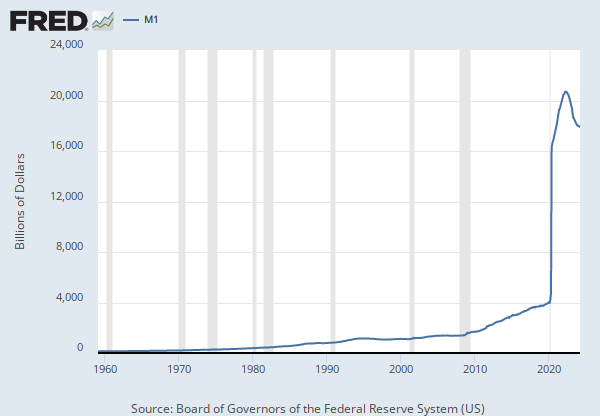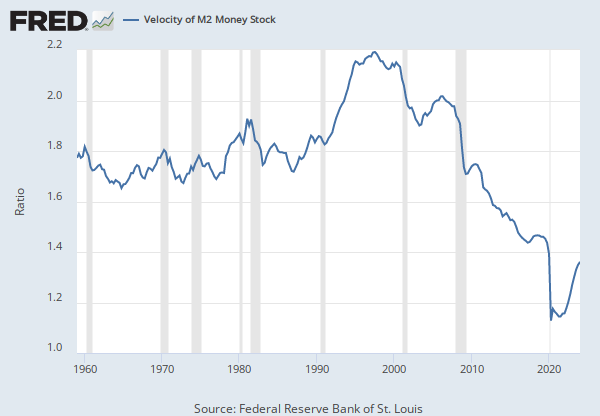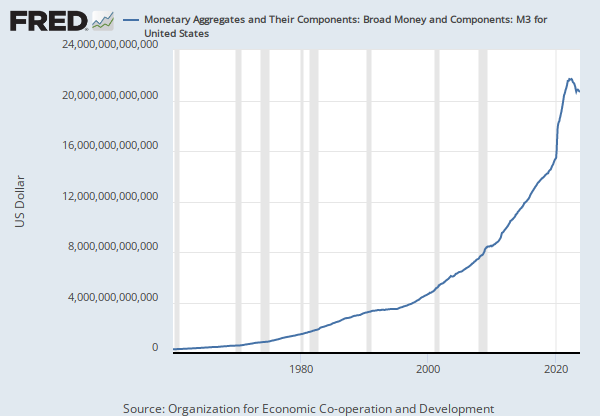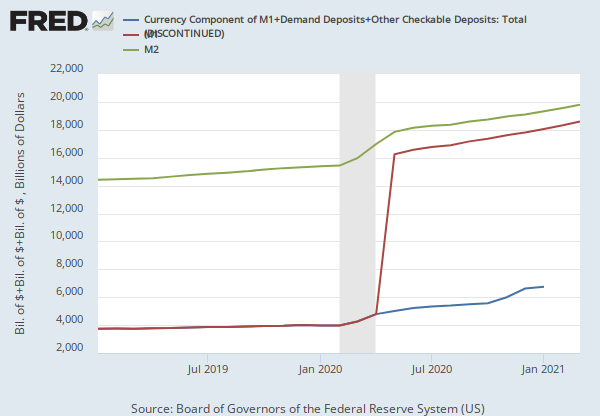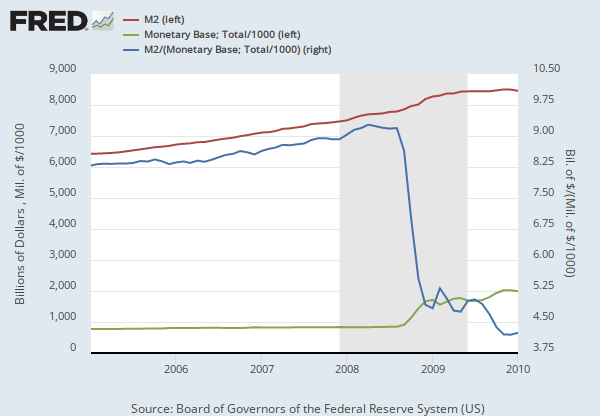Federal Reserve Economic Data: Your trusted data source since 1991
Data in this graph are copyrighted. Please review the copyright information in the series notes before sharing.
NOTES
Source: Board of Governors of the Federal Reserve System (US)
Release: H.6 Money Stock Measures
Units: Billions of Dollars, Seasonally Adjusted
Frequency: Monthly
Notes:
Before May 2020, M2 consists of M1 plus (1) savings deposits (including money market deposit accounts); (2) small-denomination time deposits (time deposits in amounts of less than $100,000) less individual retirement account (IRA) and Keogh balances at depository institutions; and (3) balances in retail money market funds (MMFs) less IRA and Keogh balances at MMFs.
Beginning May 2020, M2 consists of M1 plus (1) small-denomination time deposits (time deposits in amounts of less than $100,000) less IRA and Keogh balances at depository institutions; and (2) balances in retail MMFs less IRA and Keogh balances at MMFs. Seasonally adjusted M2 is constructed by summing savings deposits (before May 2020), small-denomination time deposits, and retail MMFs, each seasonally adjusted separately, and adding this result to seasonally adjusted M1.
For more information on the H.6 release changes and the regulatory amendment that led to the creation of the other liquid deposits component and its inclusion in the M1 monetary aggregate, see the H.6 announcements and Technical Q&As posted on December 17, 2020.
Suggested Citation:
Board of Governors of the Federal Reserve System (US), M2 [M2SL], retrieved from FRED, Federal Reserve Bank of St. Louis; https://fred.stlouisfed.org/series/M2SL, May 15, 2024.
Source: U.S. Census Bureau
Release: National Population Estimates
Units: Thousands, Not Seasonally Adjusted
Frequency: Monthly
Notes:
The intercensal estimates for 1990-2000 for the United States population are produced by converting the 1990-2000 postcensal estimates prepared previously for the U. S. to account for differences between the postcensal estimates in 2000 and census counts (error of closure). The postcensal estimates for 1990 to 2000 were produced by updating the resident population enumerated in the 1990 census by estimates of the components of population change between April 1, 1990 and April 1, 2000-- births to U.S. resident women, deaths to U.S. residents, net international migration (incl legal & residual foreign born), and net movement of the U.S. armed forces and civilian citizens to the United States. Intercensal population estimates for 1990 to 2000 are derived from the postcensal estimates by distributing the error of closure over the decade by month. The method used for the 1990s for distributing the error of closure is the same that was used for the 1980s. This method produces an intercensal estimate as a function of time and the postcensal estimates,using the following formula: the population at time t is equal to the postcensal estimate at time t multiplied by a function. The function is the April 1, 2000 census count divided by the April 1, 2000 postcensal estimate raised to the power of t divided by 3653.
Suggested Citation:
U.S. Census Bureau, Total Population: All Ages including Armed Forces Overseas [POP], retrieved from FRED, Federal Reserve Bank of St. Louis; https://fred.stlouisfed.org/series/POP, May 15, 2024.
Source: International Monetary Fund
Release: International Financial Statistics
Units: National Currency, Not Seasonally Adjusted
Frequency: Monthly
Notes:
M2 comprises notes and coins in circulation outside banking corporations; demand and savings deposits, fixed and installment savings deposits, time deposits, and certificates of deposit of households, nonfinancial corporations, local governments, securities companies, Tanshi companies, and some other financial corporations such as securities finance companies with banking corporations in national and foreign currency; and nonresident deposits with banking corporations in national currency. Beginning in April 2003, M2 comprises notes and coins in circulation outside depository corporations and demand and savings deposits, fixed and installment savings deposits, time deposits, and certificates of deposit of households, nonfinancial corporations, local governments, and some other financial corporations such as securities finance companies with banking corporations in national and foreign currency.
Copyright © 2016, International Monetary Fund. Reprinted with permission. Complete terms of use and contact details are available at http://www.imf.org/external/terms.htm.
Suggested Citation:
International Monetary Fund, M2 for Japan [MYAGM2JPM189N], retrieved from FRED, Federal Reserve Bank of St. Louis; https://fred.stlouisfed.org/series/MYAGM2JPM189N, May 15, 2024.
Source: U.S. Bureau of Labor Statistics
Release: International Comparisons of GDP per Capita and per Hour
Units: Millions of Persons, Not Seasonally Adjusted
Frequency: Annual
Notes:
For more information, see https://www.bls.gov/fls/intl_gdp_capita_gdp_hour.htm#technicalnotes.
Bureau of Labor Statistics (BLS) has eliminated the International Labor Comparisons (ILC) program. This is the last BLS release of international comparisons of GDP per capita and per hour.
Suggested Citation:
U.S. Bureau of Labor Statistics, Population in Japan (DISCONTINUED) [JPNPOPL], retrieved from FRED, Federal Reserve Bank of St. Louis; https://fred.stlouisfed.org/series/JPNPOPL, May 15, 2024.
RELEASE TABLES
RELATED DATA AND CONTENT
Data Suggestions Based On Your Search
Content Suggestions
Other Formats
M2
Monthly, Not Seasonally Adjusted Weekly, Not Seasonally AdjustedM2 for Japan
Monthly, Seasonally Adjusted



